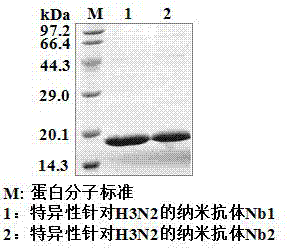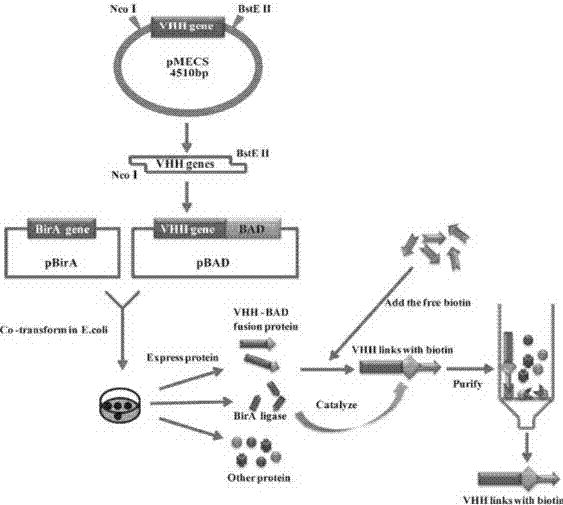Nanometer antibody for specifically aiming at H3N2 influenza A virus and application thereof in diagnosis
A H3N2, nanobody technology, applied in the field of biomedicine or biopharmaceuticals, to achieve good specificity
- Summary
- Abstract
- Description
- Claims
- Application Information
AI Technical Summary
Problems solved by technology
Method used
Image
Examples
Embodiment 1
[0042] Example 1: Construction of H3N2 Nanobody Library:
[0043] (1) Mix 0.1 mg of inactivated natural influenza A H3N2 antigen with an equal volume of Freund's adjuvant to immunize a Xinjiang Bactrian camel once a week for a total of 7 times to stimulate B cells to express antigen-specific nano Antibody; (2) After 7 times of immunization, extract 100 mL camel peripheral blood lymphocytes and extract total RNA; (3) Synthesize cDNA and amplify VHH by nested PCR; (4) Use restriction enzymes PstI and NotI Digest 20 ug pComb3 phage display vector (supplied by Biovector) and 10 ug VHH and ligate the two fragments; (5) Transform the ligated product into electroporation-competent cells TG1, construct the H3N2 nanobody library and measure the library capacity, the library size is 1.0 ×10 9 . At the same time, we randomly selected 24 clones for colony PCR detection, and the results showed that the insertion rate of the built library was above 90%. figure 1 Colony PCR results are...
Embodiment 2
[0044] Example 2: Nanobody screening process against H3N2:
[0045] (1) Dissolve in 100 mM NaHCO 3 , 20 ug of inactivated H3N2 antigen in pH 8.2 was coupled to the NUNC microtiter plate, and placed overnight at 4 ℃; (2) the next day, 100 uL of 0.1% casein was added, and blocked at room temperature for 2 h; (3) after 2 h , add 100 uL phage (5×10 11 tfu immunized camel nanobody phage display gene library), and reacted at room temperature for 1 h; (4) Washed 5 times with 0.05% PBS+Tween-20 to wash away non-specific phage; (5) Washed with 100 mM TEA (triethylamine) Dissociate the phage that specifically binds to H3N2, and infect Escherichia coli TG1 cells in logarithmic phase growth, culture at 37°C for 1 h, produce and purify the phage for the next round of screening, and repeat the same screening process for 3-4 Rounds, gradually enriched.
Embodiment 3
[0046] Example 3: Using phage enzyme-linked immunosorbent method (ELISA) to screen specific single positive clones:
[0047] (1) From the cell culture dish containing phage after the above 3-4 rounds of selection, pick 96 single colonies and inoculate them in TB medium containing 100 micrograms per milliliter of ampicillin (1 liter of TB medium contains 2.3 grams of phosphoric acid Potassium dihydrogen, 12.52 grams of dipotassium hydrogen phosphate, 12 grams of peptone, 24 grams of yeast extract, 4 milliliters of glycerol), after growing to the logarithmic phase, add IPTG with a final concentration of 1 millimolar, and culture overnight at 28 °C. (2) Use the infiltration method to obtain the crudely extracted antibody, and transfer the antibody to an antigen-coated ELISA plate, and place it at room temperature for 1 hour. (3) Wash off the unbound antibody with PBST, add a mouse anti-HA tag antibody (anti-mouse anti-HA antibody, purchased from Beijing Kangwei Century Biotech...
PUM
 Login to View More
Login to View More Abstract
Description
Claims
Application Information
 Login to View More
Login to View More - R&D
- Intellectual Property
- Life Sciences
- Materials
- Tech Scout
- Unparalleled Data Quality
- Higher Quality Content
- 60% Fewer Hallucinations
Browse by: Latest US Patents, China's latest patents, Technical Efficacy Thesaurus, Application Domain, Technology Topic, Popular Technical Reports.
© 2025 PatSnap. All rights reserved.Legal|Privacy policy|Modern Slavery Act Transparency Statement|Sitemap|About US| Contact US: help@patsnap.com



